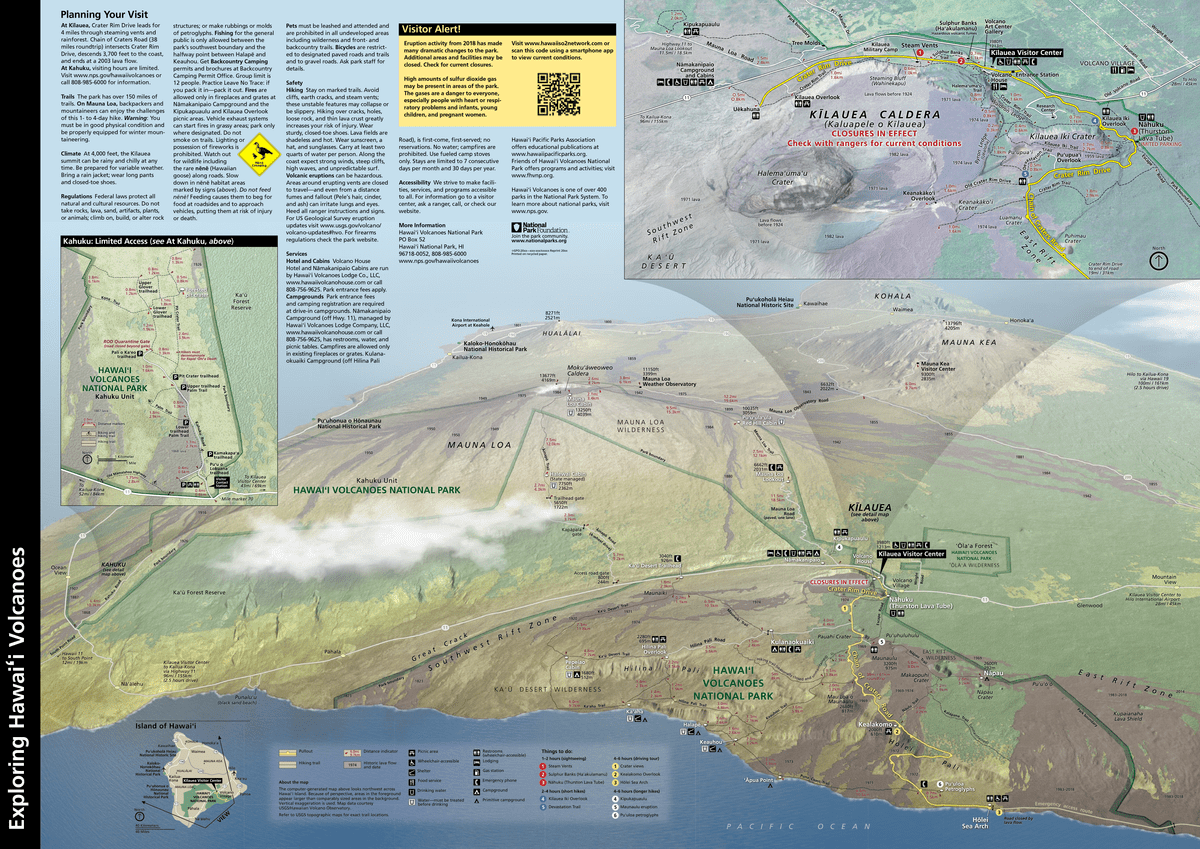Hawaiʻi Volcanoes NP--Kīpuka Puaulu
Hawaiʻi Volcanoes NP--Kīpuka Puaulu
National Park Service Page on Hiking KīpukapuauluNational Park Service Page on Birding Kīpukapuaulu
AllTrails Page on the Kīpukapuaulu Trail
Hawaiʻi Volcanoes National Park Official Website
Hawaiʻi Volcanoes National Park map
Tips for Birding
The best way to bird the area is to walk the full loop. This is an excellent setting for an hour's walk or so. The opportunities to observe native vegetation and see alien forest birds of various species at Kīpukapuaulu are wonderful; note, however, that the trail is rather short and the endangered endemic birds are uncommon or absent. Nonetheless, Kīpukapuaulu regularly produces the more common forest birds: ʻApapane are frequently seen (and heard), and ʻIo (Hawaiʻian Hawk) occur fairly often. Hawaiʻi ʻElepaio, Hawaiʻi ʻAmakihi, and ʻŌmaʻo may turn up as well. ʻIʻiwi and Alawī (Hawaiʻi Creeper) have been seen, but are much, much rarer. Nēnē (Hawaiʻian Goose) are present in the general vicinity, and may possibly be seen along Mauna Loa Road on the way to Kīpukapuaʻulu.
Birds of Interest
This is one of the best places on the island to see non-native forest birds, like Kalij Pheasant; in fact, Kīpukapuaulu is one of the best locations to observe these pheasants in the world. Interestingly, studies of Kalij Pheasants at Kīpukapuaulu have revealed that their breeding ecology in Hawaiʻi is dramatically different to their breeding ecology in their home range in Asia. In Hawaiʻi, the pheasants are cooperative breeders, which is highly unusual for galliform birds. The groups of pheasants you see along the trail at Kīpukapuaulu are likely to comprise one breeding female, along with several males and assorted immature birds; the immatures are cared for and defended by all members of the flock. Besides the Kalij Pheasants, other game birds (Erckel's Spurfowl, Gray Francolin, Ring-necked Pheasant) may be present in the open areas very close to the parking area.
A fair assortment of native species is present also, despite the rather low elevation: ʻApapane is usually fairly common, and when good ʻōhiʻa blooms are present Hawaiʻi ʻAmakihi may occur as well. ʻŌmaʻo and Hawaiʻi ʻElepaio are both semi-regular. ʻIʻiwi is very rare, and probably over-reported, due to a combination of wishful thinking and confusion with ʻApapane. There is some chance of Hawaiʻian Hawk. Note, however, that all these same sites are virtually guaranteed at other locations (like Hakalau Forest NWR) that also offer chances at rarer and more localized endemics.
Kīpukapuaulu also hosts many non-native passerines, including Red-billed Leiothrix and Chinese Hwamei. Although these two species are introduced, they prefer well-forested areas, and are not among the set of introduced birds who occur at shopping malls and resorts. This site offers good chances of viewing them.
About this Location
Kīpukapuaulu is a remnant patch of native forest, surrounded mostly by lava fields of various ages, protected within Hawaiʻi Volcanoes National Park. The first half of the name in Hawaiʻian—"kīpuka"—signifies a tract of undisturbed land hemmed in by lava flows. The alternate name for this location is Bird Park, which is apt. Additional information is available on the National Park Serviceʻs website, linked at the top of this page.
A fee is charged to enter the park; as of March 2023, the cost for a single private vehicle pass (valid for seven days) is $30. Check the official Park Service page for up-to-date information.
There is a small picnic area near the trailhead with basic restroom facilities.
About Hawaiʻi Volcanoes National Park
See all hotspots at Hawaiʻi Volcanoes National Park
Hawai‘i Volcanoes National Park protects some of the most unique geological, biological, and cherished cultural landscapes in the world. Extending from sea level to 13,680 feet, the park encompasses the summits of two of the world's most active volcanoes — Kīlauea and Mauna Loa — and is a designated International Biosphere Reserve and UNESCO World Heritage Site.
Notable Trails
The only trail at this site is the Kīpukapuaulu loop trail, which is 1.2 miles in length (with several benches and many interpretive signs). The whole of the trail is relatively flat, and should be easily accessed by all except wheelchair users. Note that dogs, horses, and bicycles are not permitted.
Features
Restrooms on site
Entrance fee
Wheelchair accessible trail
Roadside viewing
Content from Hawaiʻi Volcanoes National Park Official Website and Martin Freeland
Last updated March 4, 2023
